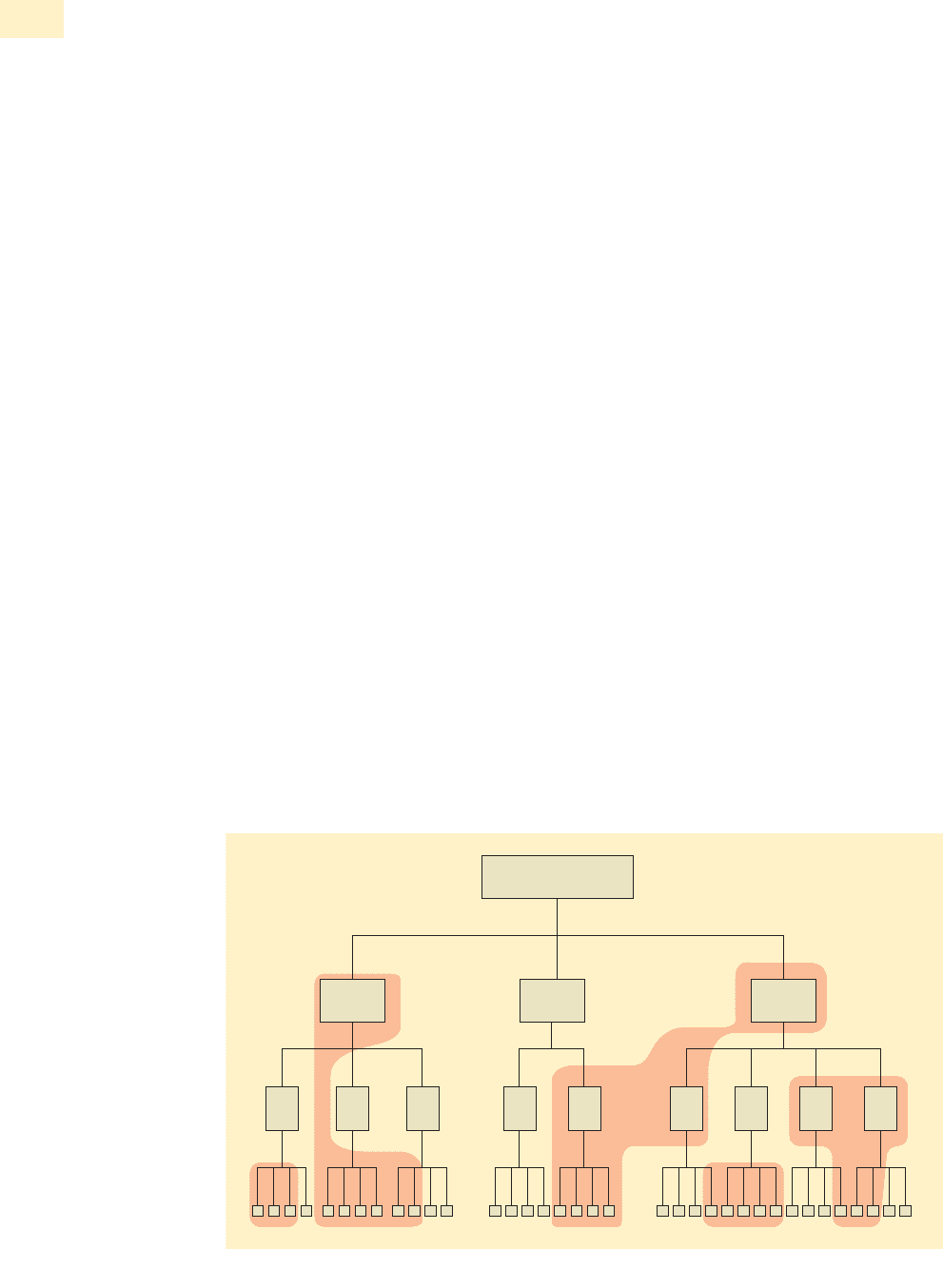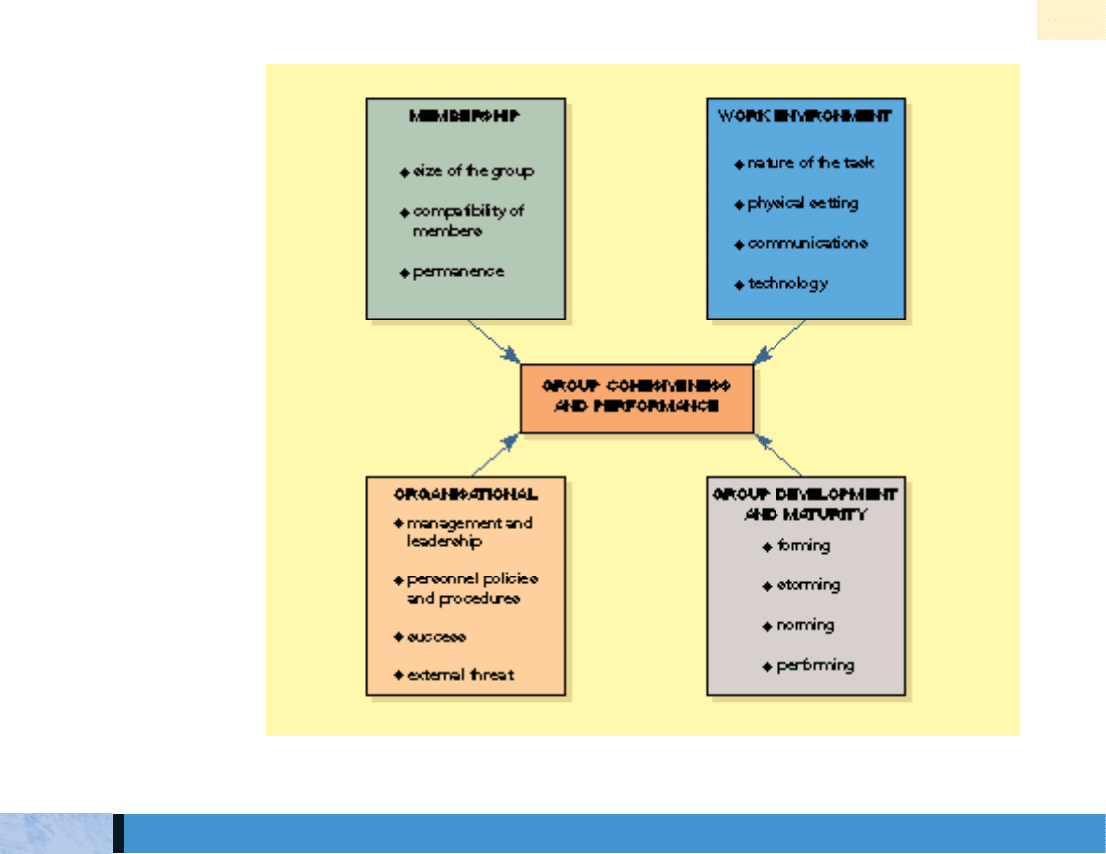Mullins L.J. Management and organisational behaviour, Seventh edition
Подождите немного. Документ загружается.


Groups are deliberately planned and created by management as part of the formal
organisation structure. However, groups will also arise from social processes and the
informal organisation which was discussed in Chapter 4. The informal organisation
arises from the interaction of people working within the organisation and the develop-
ment of groups with their own relationships and norms of behaviour, irrespective of
those defined within the formal structure. This leads to a major distinction between
formal and informal groups.
Groups are formed as a consequence of the pattern of organisation structure and
arrangements for the division of work, for example the grouping together of common
activities into sections. Groups may result from the nature of technology employed and
the way in which work is carried out, for example the bringing together of a number
of people to carry out a sequence of operations on an assembly line. Groups may
also develop when a number of people of the same level or status within the organisa-
tion see themselves as a group, for example departmental heads of an industrial
CHAPTER 13 THE NATURE OF WORK GROUPS AND TEAMS
525
up-to-date information. Conflict arising from misinformation
tended to escalate into interpersonal resentment.
Jean Kahwajy, a management consultant with the
California-based Strategic Decision Group and an author of
the HBR study, says: ‘Nasty fights mean there will be too
much politicking and wasted time.’ The study recommended
that team members prepare for meetings by focusing on the
facts. All members should have detailed knowledge of the
issues at hand and work with the same information.
An emphasis on individualism
Teams failed to deliver desired results at Apple Computer in
the 1980s, says Beer, because of the emphasis the com-
pany placed early in its existence on individualism. While
individual creativity served the company well in its initial
phase, growth heightened the need for communication
between employees.
Workers were assigned to cross-functional teams to set
corporate strategy. It did not work, according to Beer, and
the failure of Apple’s research and development, marketing
and manufacturing departments to work together under-
mined the corporation. ‘When the dominant culture
stresses the value of individual achievement and accounta-
bility, rather than collective accomplishment, team
structures won’t be effective,’ he says.
Even companies that value collective efforts may under-
mine teams by basing salaries and promotion more on
individual than on collective accomplishments. ‘Unless the
team’s success is important to the employees’ career, they
probably won’t pay much attention to it,’ says Kahwajy.
A feeling of powerlessness
To work well, teams must be able to influence decisions. Jay
Bourgeois, a professor at the University of Virginia’s business
school and co-author of the recent HBR article, says: ‘The
team that has no power ends up writing a meaningless
memo. You can only do that so many times before your
workers decide it’s not worthwhile.’ Empowerment can help
convince reluctant members of the importance of a project.
When Unifi, a company that guarantees fax delivery, asked
employees to form a team to set out Internet strategy, initial
reluctance was eventually overcome when it was made clear
that the group was helping to form corporate strategy.
The failure of senior management to work well together
This creates problems because team members may walk
into meetings with different priorities. ‘Teams can’t sort out
problems that have been created at a higher level,’ says
Beer. ‘Members can be expected to be loyal to their
bosses, and if their bosses have very different priorities,
there will be little common ground.’
Meeting-itis
Teams should not try to do everything together. Excessive
time spent in meetings not only means wasted hours, it
also means the group will be exposed to less diversity of
thought. ‘If everyone goes in with prepared thoughts and
ideas, developed on their own, discussion will be lively, and
the group will have more options,’ says Kahwajy. ‘If every-
thing is done together, a couple of lead people may end up
running the show.’ Kahwajy warns that too much homo-
geneity in teams can also stifle creativity.
Seeing teams as the solution for all problems
Bourgeois says he is working with a corporation that
expects its country managers – who are scattered all over
the world – to work as a team. ‘They have very little contact
and they don’t share the same goal, except in the very
vague sense of serving the same corporation,’ says
Bourgeois. ‘It’s silly to see them as a team.’ Moreover,
there are probably some tasks that are more readily
accomplished by individuals, rather than groups. ‘You
probably don’t want to have a group decision when you’re
landing an aircraft at Heathrow,’ he says. ‘Sometimes a
project is best carried out by a single person.’
(Reproduced with permission from the Financial Times Limited, © Financial Times)
Formal groups
FORMAL AND INFORMAL GROUPS

organisation, or chief officers of a local authority. Formal groups are created to achieve
specific organisational objectives and are concerned with the co-ordination of work
activities. People are brought together on the basis of defined roles within the struc-
ture of the organisation. The nature of the tasks to be undertaken is a predominant
feature of the formal group. Goals are identified by management, and certain rules,
relationships and norms of behaviour established.
Formal groups tend to be relatively permanent, although there may be changes in
actual membership. However, temporary formal groups may also be created by man-
agement, for example the use of project teams in a matrix organisation. Formal work
groups can be differentiated in a number of ways, for example on the basis of member-
ship, the task to be performed, the nature of technology, or position within the
organisation structure.
Within the formal structure of the organisation there will always be an informal struc-
ture. The formal structure of the organisation, and system of role relationships, rules
and procedures, will be augmented by interpretation and development at the informal
level. Informal groups are based more on personal relationships and agreement of group
members than on defined role relationships. They serve to satisfy psychological and
social needs not related necessarily to the tasks to be undertaken. Groups may devise
ways of attempting to satisfy members’ affiliation and other social motivations which
are lacking in the work situation, especially in industrial organisations.
The membership of informal groups can cut across the formal structure. They may
comprise individuals from different parts of the organisation and/or from different
levels of the organisation, both vertically and diagonally, as well as from the same hori-
zontal level. An informal group could also be the same as the formal group, or it might
comprise a part only of the formal group. (See Figure 13.4.) The members of an infor-
mal group may appoint their own leader who exercises authority by the consent of the
members themselves. The informal leader may be chosen as the person who reflects
the attitudes and values of the members, helps to resolve conflict, leads the group in
satisfying its goals, or liaises with management or other people outside the group. The
informal leader may often change according to the particular situation facing the
group. Although not usually the case, it is possible for the informal leader to be the
same person as the formal leader appointed officially by management.
526
PART 5 GROUPS AND TEAMWORK
Informal
groups
Figure 13.4 Examples of informal groups within the formal structure of an organisation

Lysons suggests four main reasons for informal groups.
■ The perpetuation of the informal group ‘culture’. Culture in this context means a
set of values, norms and beliefs which form a guide to group acceptance and group
behaviour. Unless you broadly subscribe to the group culture, you will not belong
and be an ‘outsider’ or ‘isolate’.
■ The maintenance of a communication system. Groups want all the information
that affects their welfare, either negatively or positively. If groups are not apprised of
policies and motives behind actions, they will seek to tap into formal communica-
tion channels and spread information among group members.
■ The implementation of social control. Conformity to group culture is enforced by
such techniques as ridicule, ostracism and violence. This is illustrated, for example,
by the enforcement of group norms in the Bank Wiring Room discussed above.
■ The provision of interest and fun in work life. Many jobs are monotonous and fail
to hold the attention of the workers. Work may also offer few future prospects.
Workers may try to compensate by interpersonal relations provided by the group and
in such activities as time wasting by talking, gambling, practical joking and drinking.
20
An example of informal groups
A lack of direction and clear information flow within the formal structure can give rise to
uncertainty and suspicion. In the absence of specific knowledge, the grapevine takes on
an important role, rumours start and the informal part of the organisation is highlighted,
often with negative results. A typical example concerned an industrial organisation
which was in a highly competitive market and was experiencing a drop in sales. Two top
managers had suddenly lost their jobs without any explanation to members of staff and
there were board meetings seemingly every other day. Although there was no specific
information or statements from top management the general feeling among the staff was
that whatever was about to happen it was most unlikely to be good news.
At lunchtime three junior members of staff, one female and two male, each from
different departments, were having a chat. With a half smile the female member said
to the others that she could well be seeing a lot more of both or at least one of them
before long. She said that she had heard, unofficially, from her manager that the
department was about to be awarded a very profitable order. She surmised that the
other departments, which she had also heard had lost their parts of the same contracts
and not had many orders recently, would have to integrate into the successful depart-
ment with the possible loss of certain jobs. The other two members both believed this
and talked about it within their own departments as if it were a fact. The result? Even
more uncertainty throughout the organisation, increased gloom and distraction from
the task. In fact, no such integration did take place, only a minor restructuring of the
organisation with no direct loss of jobs other than through voluntary early retirement.
However, it proved very difficult for top management to effectively quash the rumour
and restore trust and morale.
Individuals will form into groups or teams, both formal and informal, for a number of
different reasons relating to both work performance and social processes.
■ Certain tasks can be performed only through the combined efforts of a number
of individuals working together. The variety of experience and expertise among
members provides a synergetic effect which can be applied to the increasingly com-
plex problems of modern organisations.
CHAPTER 13 THE NATURE OF WORK GROUPS AND TEAMS
527
Major
functions of
informal
groups
REASONS FOR FORMATION OF GROUPS OR TEAMS

■ Collusion between members in order to modify formal working arrangements more
to their liking – for example, by sharing or rotating unpopular tasks. Membership
therefore provides the individual with opportunities for initiative and creativity.
■ Companionship and a source of mutual understanding and support from col-
leagues. This can help in solving work problems, and also to militate against
stressful or demanding working conditions.
■ Membership provides the individual with a sense of belonging. It provides a feel-
ing of identity, and the chance to acquire role recognition and status within the
group or team.
■ Guidelines on generally acceptable behaviour. It helps to clarify ambiguous situa-
tions such as, for example, the extent to which official rules and regulations are
expected to be adhered to in practice, the rules of the game, and what is seen as the
correct actual behaviour. The informal organisation may put pressure on members
to resist demands from management on such matters as, for example, higher output
or changes in working methods. Allegiance to the group or team can serve as a
means of control over individual behaviour and discipline individuals who contra-
vene the norms – for example, the process of ‘binging’ in the bank wiring room,
mentioned above.
■ Protection for its membership. Group or team members collaborate to protect their
interests from outside pressures or threats.
Individuals have varying expectations of the benefits from group membership. Groups
are a potential source of motivation and of job satisfaction, and also a major determi-
nant of effective organisational performance. However, working in groups may mean
that members spend too much time talking among themselves rather than doing.
Groups may also compete against each other in a non-productive manner. It is a ques-
tion of balance. It is important, therefore, that the manager understands the reasons
for the formation of groups and is able to recognise likely advantageous or adverse con-
sequences for the organisation.
Social interaction is a natural feature of human behaviour but ensuring harmonious
working relationships and effective teamwork is not an easy task. The manager’s main
concern is that members of a work group co-operate in order to achieve the results
expected of them. Although there are potential disadvantages of cohesive groups (dis-
cussed below) they may result in greater interaction between members, mutual help
and social satisfaction, lower turnover and absenteeism, and often higher production.
21
Co-operation among members is likely to be greater in a united, cohesive group.
Membership of a cohesive group can be a rewarding experience for the individual, can
contribute to the promotion of morale, and aid the release of creativity and energy.
Members of a high-morale group are more likely to think of themselves as a group and
work together effectively. Strong and cohesive work groups can, therefore, have
beneficial effects for the organisation.
In order to develop the effectiveness of work groups the manager will be concerned
with those factors that contribute to group cohesiveness, or that may cause frustration
or disruption to the operation of the group. The manager needs to consider, therefore,
both the needs of individual members of staff, and the promotion of a high level of
group identity and cohesion. There are many factors which affect group cohesiveness
and performance, which can be summarised under four broad headings, as shown in
Figure 13.5.
528
PART 5 GROUPS AND TEAMWORK
Expectations
of group
membership
GROUP COHESIVENESS AND PERFORMANCE
Factors
affecting
cohesiveness

As a group increases in size, problems arise with communications and co-ordination.
Large groups are more difficult to handle and require a higher level of supervision.
Absenteeism also tends to be higher in larger groups. When a group becomes too large
it may split into smaller units and friction may develop between the sub-groups.
It is difficult to put a precise figure on the ideal size of a work group and there are
many conflicting studies and reports. Much will depend upon other variables, but it
seems to be generally accepted that cohesiveness becomes more difficult to achieve
when a group exceeds 10–12 members.
22
Beyond this size the group tends to split into
sub-groups. A figure of between five and seven is often quoted as an apparent optimum
size for full participation within the group.
23
Many readers will be familiar with the clas-
sic 1957 movie Twelve Angry Men in which one juror persuades the other 11 to change
their minds over a murder verdict. This drew attention to a range of intra-group con-
flicts and the difficulty in groups of more than 10 people reaching consensus.
Cane asks the question: how many people should be in a team?
The answers from different organizations as to what is the perfect number vary from between four
and fifteen depending on a whole range of variables. Fifteen is about the maximum number of
people anyone can communicate with without having to raise their voice significantly and any
less than four has a restriction in the amount of creativity and variety that can be produced. It is
interesting to note that these figures range between the maximum and minimum numbers of
sports teams – perhaps less of a coincidence than it seems.
24
CHAPTER 13 THE NATURE OF WORK GROUPS AND TEAMS
529
Figure 13.5 Factors contributing to group cohesiveness and performance
MEMBERSHIP
Size of
the group

The more homogeneous the group in terms of such features as shared backgrounds,
interests, attitudes and values of its members, the easier it is usually to promote cohe-
siveness. Variations in other individual differences, such as the personality or skills of
members, may serve to complement each other and help make for a cohesive group.
On the other hand, such differences may be the cause of disruption and conflict.
Conflict can also arise in a homogeneous group where members are in competition
with each other. Individual incentive payment schemes, for example, may be a source
of conflict.
Group spirit and relationships take time to develop. Cohesiveness is more likely when
members of a group are together for a reasonable length of time, and changes occur
only slowly. A frequent turnover of members is likely to have an adverse effect on
morale, and on the cohesiveness of the group.
Where workers are involved in similar work, share a common task, or face the same
problems, this may assist cohesiveness. The nature of the task may serve to bring
people together when it is necessary for them to communicate and interact regularly
with each other in the performance of their duties – for example, members of a
research and development team. Even if members of a group normally work at differ-
ent locations they may still experience a feeling of cohesiveness if the nature of the
task requires frequent communication and interaction – for example, security guards
patrolling separate areas who need to check with each other on a regular basis.
However, where the task demands a series of relatively separate operations or discrete
activities – for example, on a machine-paced assembly line – it is more difficult to
develop cohesiveness. Individuals may have interactions with colleagues on either side
of them but little opportunity to develop a common group feeling.
Where members of a group work in the same location or in close physical proximity to
each other this will generally help cohesiveness. However, this is not always the case.
For example, in large open-plan offices staff often tend to segregate themselves from
colleagues and create barriers by the strategic siting of such items as filing cabinets,
bookcases or indoor plants. The size of the office and the number of staff in it are, of
course, important considerations in this case. Isolation from other groups of workers
will also tend to build cohesiveness. This often applies, for example, to a smaller
number of workers on a night shift.
The more easily members can communicate freely with each other, the greater the like-
lihood of group cohesiveness. Communications are affected by the work environment,
by the nature of the task, and by technology. For example, difficulties in communica-
tion can arise with production systems where workers are stationed continuously at a
particular point with limited freedom of movement. Even when opportunities exist for
interaction with colleagues, physical conditions may limit effective communication.
For example, the technological layout and high level of noise with some assembly line
work can limit contact between workers. Restrictions on opportunities for social inter-
action can hamper internal group unity.
We can see that the nature of technology and the manner in which work is carried out
has an important effect on cohesiveness, and relates closely to the nature of the task,
physical setting and communications. Where the nature of the work process involves a
craft or skill-based ‘technology’ there is a higher likelihood of group cohesiveness.
530
PART 5 GROUPS AND TEAMWORK
Compatibility
of the
members
Permanence
of group
members
WORK ENVIRONMENT
The nature of
the task
Physical
setting
Communications
Technology

However, as mentioned earlier, with machine-paced assembly line work it is more diffi-
cult to develop cohesiveness. Technology also has wider implications for the operation
and behaviour of groups and therefore is considered in a separate section later.
The activities of groups cannot be separated from management and the process of lead-
ership. The form of management and style of leadership adopted will influence the
relationship between the group and the organisation, and is a major determinant of
group cohesiveness. In general terms, cohesiveness will be affected by such things as
the manner in which the manager gives guidance and encouragement to the group,
offers help and support, provides opportunities for participation, attempts to resolve
conflicts, and gives attention to both employee relations and task problems. McKenna
and Maister draw attention to the importance of the group leader establishing a level of
trust among the group by helping them understand the behaviours that build trust.
‘The job of the group leader is to encourage people to earn the trust of others in their
group and then show them how it can translate into greater commitment, greater cre-
ativity, greater professional satisfaction, and better performance.’
25
Harmony and cohesiveness within the group are more likely to be achieved if person-
nel policies and procedures are well developed, and perceived to be equitable with fair
treatment for all members. Attention should be given to the effects that appraisal sys-
tems, discipline, promotion and rewards, and opportunities for personal development
have on members of the group.
The more successful the group, the more cohesive it is likely to be; and cohesive groups
are more likely to be successful. Success is usually a strong motivational influence on
the level of work performance. Success or reward as a positive motivator can be per-
ceived by group members in a number of ways. For example, the satisfactory
completion of a task through co-operative action; praise from management; a feeling
of high status; achievement in competition with other groups; benefits gained, such as
high wage payments from a group bonus incentive scheme.
Cohesiveness may be enhanced by members co-operating with one another when
faced with a common external threat, such as changes in their method of work, or the
appointment of a new manager. Even if the threat is subsequently removed, the group
may still continue to have a greater degree of cohesiveness than before the threat
arose. Conflict between groups will also tend to increase the cohesiveness of each
group and the boundaries of the group become drawn more clearly.
The degree of cohesiveness is affected also by the manner in which groups progress
through the various stages of development and maturity before getting down to the
real tasks in hand. This process can take time and is often traumatic for the members.
Bass and Ryterband identify four distinct stages in group development:
■ mutual acceptance and membership;
■ communication and decision-making;
■ motivation and productivity; and
■ control and organisation.
26
CHAPTER 13 THE NATURE OF WORK GROUPS AND TEAMS
531
ORGANISATIONAL FACTORS
Management
and leadership
Personnel
policies and
procedures
Success
External threat
GROUP DEVELOPMENT AND MATURITY

An alternative, and more popular, model by Tuckman also identifies four main succes-
sive stages of group development and relationships: forming, storming, norming and
performing.
27
■ Stage 1 – forming. The initial formation of the group and the bringing together of a
number of individuals who identify, tentatively, the purpose of the group, its com-
position and terms of reference. At this stage consideration is given to hierarchical
structure of the group, pattern of leadership, individual roles and responsibilities,
and codes of conduct. There is likely to be considerable anxiety as members attempt
to create an impression, to test each other, and to establish their personal identity
within the group.
■ Stage 2 – storming. As members of the group get to know each other better they
will put forward their views more openly and forcefully. Disagreements will be
expressed and challenges offered on the nature of the task and arrangements made
in the earlier stage of development. This may lead to conflict and hostility. The
storming stage is important because, if successful, there will be discussions on
reforming arrangements for the working and operation of the group, and agreement
on more meaningful structures and procedures.
■ Stage 3 – norming. As conflict and hostility start to be controlled members of the
group will establish guidelines and standards, and develop their own norms of
acceptable behaviour. The norming stage is important in establishing the need for
members to co-operate in order to plan, agree standards of performance and fulfil
the purpose of the group. This co-operation and adherence to group norms can
work against effective organisational performance. It may be remembered, for ex-
ample, that, in the bank wiring room experiment of the Hawthorne studies, group
norms imposed a restriction on the level of output of the workers.
■ Stage 4 – performing. When the group has progressed successfully through the three
earlier stages of development it will have created structure and cohesiveness to work
effectively as a team. At this stage the group can concentrate on the attainment of its
purpose and performance of the common task is likely to be at its most effective.
Another writer suggests that new groups go through the following stages:
■ the polite stage;
■ the why are we here, what are we doing stage?
■ the power stage, which dominant will emerge?
■ the constructive stage when sharing begins; and
■ the unity stage – this often takes weeks, eating together, talking together.
28
If the manager is to develop effective work groups then attention should be given to
those factors which influence the creation of group identity and cohesiveness.
However, strong and cohesive groups also present potential disadvantages for manage-
ment. Cohesive groups do not necessarily produce a higher level of output.
Performance varies with the extent to which the group accepts or rejects the goals of
the organisation. Furthermore, with a very high level of cohesiveness and attention to
social activities, there may even be a fall in output. The level of production is likely to
conform to a standard acceptable as a norm by the group and may result in maintain-
ing either a high or a restricted level of output.
29
Individual differences in personality mean that people make a contribution to the
work of the organisation in different ways and this influences the extent to which they
wish to be committed to a group or team culture. For example, as Green points out:
532
PART 5 GROUPS AND TEAMWORK
POTENTIAL DISADVANTAGES OF STRONG, COHESIVE GROUPS

‘Some people find teamwork contrary to their normal style and are embarrassed; some
are probably marginalised.’
30
People also have a greater or lesser need for personal space and their own sense of
individual identity.
Once a group has become fully developed and created cohesiveness, it is more diffi-
cult for the manager successfully to change the attitudes and behaviour of the group.
It is important that the manager should attempt to influence the group during the
norming stage when members are establishing guidelines and standards, and their
own norms of acceptable behaviour. When a group has become fully developed and
established its own culture it is more difficult to change the attitudes and behaviour
of its members.
Strong, cohesive groups may develop a critical or even hostile attitude towards people
outside the group or members of other groups. This can be the case, for example, when
group cohesiveness is based on common status, qualifications, technical expertise or
professional standing. Group cohesiveness may result in lack of co-operation with, or
opposition to, non-members. As a result, resentment and inter-group conflict may arise
to the detriment of the organisation as a whole. In order to help prevent, or overcome,
unconstructive inter-group conflict, the manager should attempt to stimulate a high
level of communication and interaction between the groups, and to maintain har-
mony. Rotation of members among different groups should be encouraged.
On the other hand, inter-group rivalry may be deliberately encouraged as a means of
building stronger within-group cohesiveness.
32
The idea is that a competitive element
may help to promote unity within a group. However, inter-group rivalry and competi-
tion need to be carefully handled by the manager. Groups should not normally be put
in a situation where they have to compete for resources, status or approval.
33
The manager should attempt to avoid the development of ‘win–lose’ situations.
Emphasis should be placed on overall objectives of the organisation and on superordi-
nate goals. These are goals over and above the issues at conflict and which, if they are
to be achieved, require the co-operation of the competing groups.
The characteristics of an effective work group are not always easy to isolate clearly. The
underlying feature is a spirit of co-operation in which members work well together as a
united team, and with harmonious and supportive relationships. This may be evi-
denced when members of a group exhibit:
■ a belief in shared aims and objectives;
■ a sense of commitment to the group;
■ acceptance of group values and norms;
■ a feeling of mutual trust and dependency;
CHAPTER 13 THE NATURE OF WORK GROUPS AND TEAMS
533
Everyone had at least a handful of items they preferred to keep private: love letters, photo-
graphs, mementoes, a personal journal, whatever. Nothing shameful was likely to be hidden
in the lockers ... The purpose of the lockers was merely to maintain a totally personal space as
a way to preserve each person’s necessary sense of identity in a claustrophobic and commu-
nalenvironment where, in time, it was easy to feel absorbed into a group identity and thereby
become psychologically disassociated and quietly depressed.
Dean Koontz
31
Inter-group
conflict
CHARACTERISTICS OF AN EFFECTIVE WORK GROUP

■ full participation by all members and decision-making by consensus;
■ a free flow of information and communications;
■ the open expression of feelings and disagreements;
■ the resolution of conflict by the members themselves; and
■ a lower level of staff turnover, absenteeism, accidents, errors and complaints.
However, as Brooks points out, as teams operate at the higher order of group dynamics
this list is arguably more reflective of ‘effective work teams rather than work groups
and this is how it should be – these are teams not groups’.
34
Understanding group behaviour
The effective management of work groups requires an understanding of the psycho-
logical and social influences on behaviour within organisations. Allcorn distinguishes
between defensive and non-defensive work groups, and provides a typology based on
four differing sets of culture.
35
■ Homogenised Defensive groups. They provide collective and
■ Institutionalised
}
individual defences against anxiety that results
■ Autocratic from group membership.
■ Intentional Non-defensive group. Deals with group participation in a
non-defensive way. The type of group that is desirable in
the workplace.
Attempting to change the culture of a defensive group into that of an intentional
group in not easy. The intervention strategy is likely to be perceived as threatening to
members of the group. Allcorn suggests that successful intervention involves the com-
parisons of perceptions and understandings in order to provide a thoughtful summary
of the group’s perceptions which is accepted by the members. This requires sensitivity
to the anxiety of group members and the forces that militate against change. Members
need to understand the actions associated with the intentional group as a basis for
establishing and maintaining an intentional culture. Allcorn reminds us that ‘individ-
ual and group behaviour is highly complex, difficult to understand and even more
difficult to manage’. It is important to further develop group-process skills.
Working in groups and teams, and the analysis of individual behaviour are discussed
in Chapter 14.
The nature of technology and the work flow system of the organisation is a major
determinant of the operation of groups, and the attitude and behaviour of their mem-
bers. Low morale and a negative attitude towards management and the job are often
associated with a large number of workers undertaking similar work. A number of dif-
ferent early studies have drawn attention to the relationship between technology and
work groups.
36
The nature of technology and the work organisation can result in a feel-
ing of alienation, especially among manual workers. Factors which have been shown to
affect alienation include the extent to which the work of the individual or the group
amounts to a meaningful part of the total production process, and the satisfaction
which workers gain from relationships with fellow workers and group membership.
Recall the work of Trist and others in their study of changing technology in the coal
mining industry (discussed in Chapter 3). New technological methods resulted in
changes to the previous system of group working and disrupted traditional social rela-
tionships and the integration of small groups.
37
534
PART 5 GROUPS AND TEAMWORK
Changing the
culture of
a group
THE EFFECTS OF TECHNOLOGY ON WORK GROUPS
